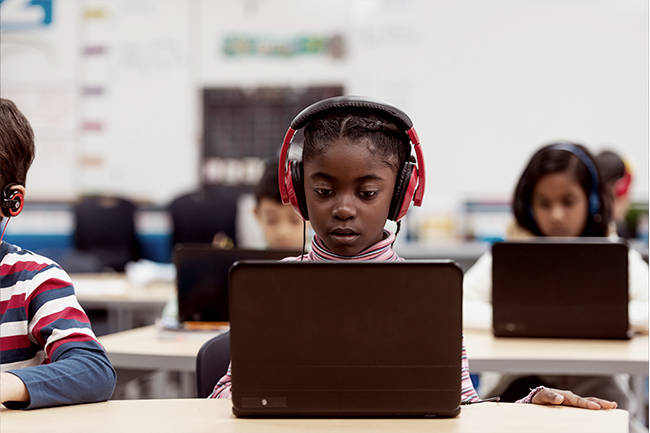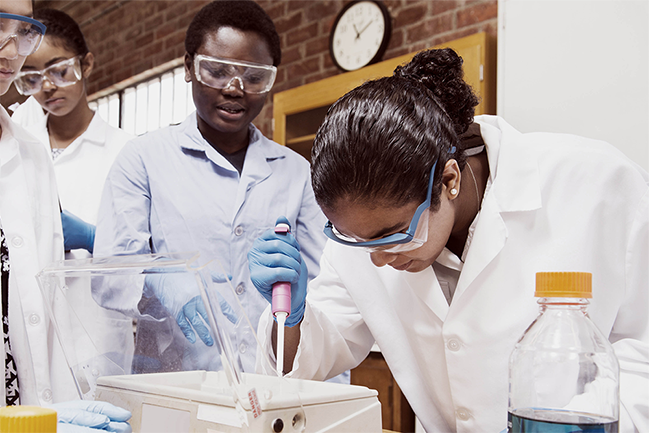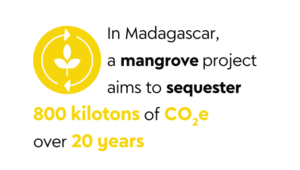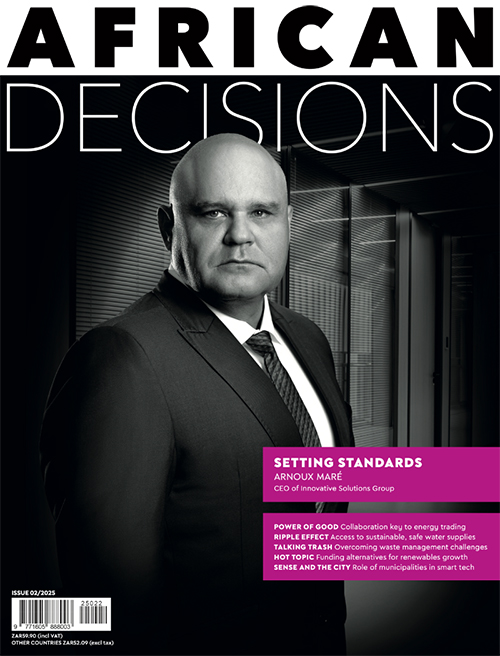‘Technology needs girls to help invent the future.’ There are many reasons – and we’ll get into them – why more girls and women are needed in STEM professions, but this mantra is perhaps the most compelling, posited by Tinyiko Simbine, CFO/COO of GirlCode, a South African NPO aimed at empowering girls to learn to code.
If we take a hopeful rather than pessimistic view of sub-Saharan Africa’s growing population (which is predicted to double by 2050, growing at 2.7% a year, which is more than twice as fast as South Asia and Latin America), every new mind born has the potential to formulate solutions to the myriad problems faced by this resource-rich yet underdeveloped region – male and female. That is, if said minds receive an education. More specifically, STEM education.
Encouragingly, Africa is a world leader in a significant category – Benin has the biggest share of women graduates in the field of engineering in the world and ranks sixth globally in terms of its female ICT graduates.
According to a recent report compiled by Times Higher Education and the UN Scientific, Cultural and Educational Organisation, among universities polled in Africa, 47% of STEM graduates, undergraduates and postgraduates were women. However, it notes that women remain outnumbered at student and academic staff levels generally. For every 100 sub-Saharan African male students enrolled in tertiary education in 2019, there were 76 female students.
Further up the career ladder, statistics are less encouraging (18% to 31% of science researchers in sub-Saharan Africa are women), as well as further down: US public policy research NPO the Brookings Institute shares from its Foresight Africa 2022 report that at primary-school level, girls in sub-Saharan Africa perform as well as or even better than boys globally in mathematics and science performance. However, only 3% to 7% of girls who attend higher education actually study STEM-related courses when they get there. ‘More specifically, 3% of girls in higher education are enrolled in ICT, compared to 8% of boys. Similarly, 7% of girls enrolled in engineering and construction courses compared to 22% of boys who enrolled for the same fields of study.’
Africa is changing rapidly, both economically and socially, with analysts predicting it will play a greater role in world affairs in the future. Yet there are still enormous challenges, particularly for women and girls – from repressive socio-cultural norms (such as child marriage and pregnancy) to a lack of education and poverty, making it all the more important to equip them with education in STEM subjects.
A 2020 UN Children’s Fund report titled Re-imagining Girls Education through STEM predicts that between 40 million and 160 million women will need to transition between occupations by 2030, often into more skilled roles requiring more complex digital, cognitive, social and emotional skills.
‘If girls and women are not ready and able to navigate these transitions successfully, they will lose more productive and better-paid work opportunities. Even worse, it may reverse progress in female labour market participation.’ The report found that girls in sub-Saharan Africa of primary-education age continue to significantly lag behind boys in mathematics achievement, although in science girls tend to perform, on average, as well as boys.
‘Girls and women constitute half of the global population; adopting gender inclusion in STEM is essential for increasing innovations, creativity, gender-sensitive perspectives for products, and productivity [in Africa],’ says Olubukola Oluranti Babalola, a professor and VP of the Organisation for Women in Science for the Developing World Africa (OWSD) and research director at North West University in South Africa.
‘Naturally, a more diverse team is more likely to succeed than a more homogeneous team. Participation of both genders breeds new insights and ideas that promote growth and productivity,’ she says. ‘Scientific training and expertise are essential for the girl child to maximise her potential, since science education creates critical thinkers, increases science literacy, and empowers the next generation of innovators.’
‘Science shapes our material, intellectual and cultural environments; it gives students a vision and helps them find a passion for what they want to do in the future. Just as important, science plays a key role in sustaining the growth and stability of [African] economies, improving the professional development of workers. Scientific skills are now required in most jobs. STEM careers, therefore, grow faster than average. STEM education is crucial to meet the needs of today’s industries, and is one of the keys to alleviating unemployment.’

According to the Foresight Africa report, specific strategies and tools for boosting girl child involvement in STEM are already known – use role models; create learning resources that portray the girl child in STEM; encourage interest in STEM early in education. Babalola reiterates this, as well as the need for collaborative learning environments.
‘Girls between the ages of eight and 16 learn more effectively when they work together and are not competing. Connecting with female role models in STEM fields who can act as mentors and examples of success stories can motivate young girls. Role models that act as catalysts for 8th and 9th-grade girls, who are just discovering their interests and are beginning their career trajectories. Creating learning resources – text books, e-learning resources – that portray girls in STEM is another way to help girls to see themselves in these roles.’
She points out that most initiatives to increase involvement in STEM fields focus on higher education; at this stage, girls are already lagging and under-represented in STEM fields. ‘The capability of teachers, and STEM teachers, in particular, must be built up as a priority by African authorities.’
OWSD has been working in Africa since 1997 to improve the number and quality of women scientists and has provided full PhD scholarships to nearly 400 women from 30 countries in sub-Saharan Africa. But there are many other organisations aimed at fostering girls’ interest in STEM at a younger age.
GirlCode, for example, is on a mission to empower 10 million African women and girls with tech skills – namely, coding – by 2030, and has so far had an impact on more than 60 000 girls and women, and placed 100 girls in coding/STEM jobs via its Employer Partner Network, including eight living and working in the UK.

‘The use of digital skills has become part of our lives, with many activities facilitated by and through the use of technology,’ says Simbine. ‘African girls need to be given more access to these skills not only to survive but to thrive in a digitally advanced world. Especially in a country where there are millions of unemployed young people, it’s important to break the existing stereotypes that technology careers are ‘too hard’ for girls.’
GirlCode was born from ‘multiple frustrations’ says Simbile. ‘Zandile Mkwanazi, one of my co-founders, would attend competitive hackathons, and it would leave her wondering where the females were. Myself and Jeanette Theu, our third co-founder, saw the lack of female representatives in our everyday life working for big IT companies. In 2015, we joined forces to create and build what we now know as GirlCode.’
Simbine echoes Babalola’s lament at the dearth of female role models in STEM. ‘There’s a lack of female leaders whom they can look up to. As a young girl, it is very important for you to have role models who look just like you, to give you that extra push. Your ability to thrive and succeed increases. Our vision at GirlCode is to create a network of women who are highly skilled in software develop-ment and leadership skills, and who will contribute towards an inclusive and innovative technology industry. We plan on growing our GirlCoders into becoming leaders and, in turn, paying it forward for the younger girls who are coming up under them.’
The private sector is waking up to the advantages of empowering girls in STEM. GirlCode receives support from IT company Accenture; digital-tech organisation Falcorp; food producer and fashion retailer AVI; IT consultants Byte Orbit; software firm BBD; fibre provider Vuma; software developers Mint and Opti-Num Solutions; social-impact programme Naspers Labs; analytics and digital solutions company EXL; and cloud computing providers Amazon Web Service and Oracle.

The African Institute of Maths Science has partnered with the Mastercard Foundation to reach 1 million secondary school students within five years by training 10 000 teachers in Rwanda and Cameroon. The gender-responsive teacher training programme is improving STEM learning outcomes for secondary school students, especially girls, to build a pipeline of STEM talent in Africa.
Then there’s Fly for STEAM, a campaign in which a team of ambassadors fly around the continent in a small aeroplane to encourage girls to consider careers in the STEM field, with a focus on aviation and space. (STEAM is a variation of STEM, with the addition of Arts, which some suggest expands the limits of STEM education and application.)
In 2009, helicopter and fixed-wing pilot Refilwe Ledwaba founded Southern African Women in Aviation and Aerospace, and the organisation subsequently established the Girls Fly Programme in Africa (GFPA) along with a GFPA Foundation, sponsored by private companies such as Safair, Wilderness Air and various private interests in the airline and hospitality industries. To date 500 girls across Botswana, Cameroon, Kenya and South Africa have attended GFPA’s aviation and space technology camps, and 20 girls have received full scholarships.
In August, edutech start-up MathsGee launched its annual campaign targeting young girls to take up STEM subjects with its 1 000 Answers campaign, posing the question, ‘how can we get more girls to thrive in STEM subjects and careers?’, and inviting the public to participate in formulating solutions. MathsGee previously partnered with organisations such as SABC Education, L’Oréal, GenderLinks and UN Women, among others, to support greater participation of girls in STEM.
While it’s easy to list organisations and initiatives aimed at empowering girls in sub-Saharan Africa to choose STEM careers, the focus remains on the provision of such programmes, when it needs to expand to include measurable results.
Until such time as the effectiveness of efforts to correct the STEM gender gap in sub-Saharan Africa are addressed, there’s no way to know how big an impact they’re having, and which ones to scale. Even so, it’s clear the continent is on a positive trajectory regarding women in STEM.

















